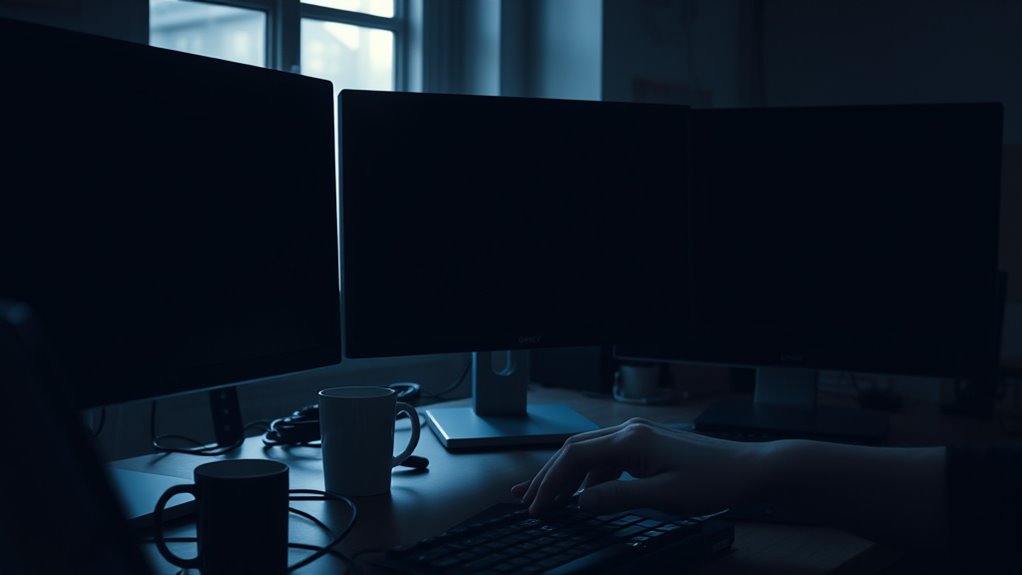If your monitors keep going black, it could be due to several reasons. Hardware issues like age or faulty components might be causing problems. Software conflicts or outdated drivers can also lead to display issues. Additionally, unstable power supplies and loose or damaged cables can interrupt signals. Overheating from poor ventilation attracts other issues as well. Understanding these factors can help identify the root cause, and there’s more to uncover on how to fix them.
Common Hardware Issues
When your monitors keep going black, it often points to common hardware issues that you can troubleshoot. First, consider the age of your monitors; older models may simply be reaching the end of their lifespan. Faulty components, like cables or power supplies, could also be to blame. Check the connections to verify they’re secure and undamaged. If you notice flickering before the blackout, this might indicate an internal issue, such as a failing display panel. Testing your monitors on a different computer can help isolate the problem. By identifying these hardware issues early, you can take the necessary steps to maintain your setup and enjoy the freedom of a reliable display.
Software and Driver Conflicts
Although hardware issues are a common culprit, software and driver conflicts can also cause your monitors to go black unexpectedly. One of the main reasons for this is outdated software updates or incompatible drivers that can interfere with your display settings. If your graphics driver isn’t compatible with your operating system, it might lead to display issues. Regularly checking for and installing the latest software updates can help maintain compatibility and functionality. Additionally, if you’ve recently updated your system or installed new software, it’s wise to verify that all drivers are still aligned with your hardware. Identifying and resolving these conflicts can restore your monitors to their normal operation, freeing you from the frustration of unexpected black screens.
Power Supply Problems
If your monitors keep going black, power supply problems might be at play. Power fluctuations can cause your monitors to lose signal, leading to frustrating black screens. If your power supply isn’t stable, it can affect how your components function, resulting in display issues. You might also have faulty components that aren’t providing the necessary power to your monitors. This could include a failing power supply unit or damaged cables. To diagnose the issue, check for any signs of wear on your power supply and verify it’s functioning properly. You deserve a smooth experience, so resolving these power supply concerns is essential for maintaining your monitor’s performance. Don’t let these problems hold you back from enjoying your setup!
Connection and Cable Troubles
Since connection and cable troubles can often lead to unexpected black screens, it’s essential to guarantee everything is securely connected. Check your cable types and verify they match your monitor and graphics card specifications. Poor connection quality can also arise from damaged or loose cables, so inspect them closely.
Here’s a simple table to help you identify common cable types and their potential issues:
| Cable Type | Common Issues |
|---|---|
| HDMI | Loose connection, wear |
| DisplayPort | Compatibility, damage |
| VGA | Signal degradation, corrosion |
Overheating and Environmental Factors
When your monitors keep going black, overheating could be a significant factor, especially if they’re placed in an environment that doesn’t allow for proper airflow. High ambient temperatures can lead to increased internal temperatures in your monitors, causing them to shut down to prevent damage. If your setup is cramped with airflow restrictions, dust buildup can further exacerbate this issue.
Ensure your monitors have enough space around them for ventilation. Regularly clean dust from vents and consider using fans or air conditioning to maintain a cooler environment. If you notice your monitors overheating, take action quickly. Ignoring this can lead to permanent damage, so prioritize their well-being for a smooth, uninterrupted viewing experience.
Frequently Asked Questions
Can Faulty Graphics Cards Cause Monitor Blackouts?
Yes, faulty graphics cards can definitely cause monitor blackouts. During monitor troubleshooting, consider graphics card issues like overheating or driver conflicts. Addressing these problems can restore your monitors and give you the freedom to enjoy your setup again.
How Often Should I Clean My Monitors?
You should clean your monitors every few months for ideal monitor maintenance. Use gentle cleaning techniques, like microfiber cloths and suitable solutions, to keep screens clear without damaging them. Regular care enhances their lifespan and performance.
What Should I Do if My Monitor Is Under Warranty?
If your monitor’s under warranty, contact the manufacturer for warranty claims. They’ll guide you through repair options. Be sure to have your purchase details handy for a smoother process and quicker resolution.
Are Certain Monitor Brands More Prone to Blackouts?
Certain brands may indeed be more prone to blackouts, often due to differences in monitor reliability. When making brand comparisons, consider user reviews and warranty policies to verify you choose a dependable option for your needs.
How Can I Test My Monitor for Defects?
To test your monitor for defects, adjust the display settings and perform monitor calibration. Look for color inconsistencies or flickering. If issues persist, consider using a different cable or connecting to another device for comparison.

